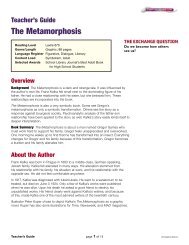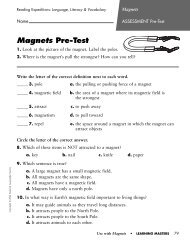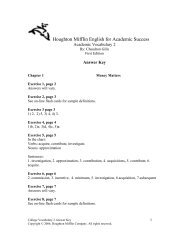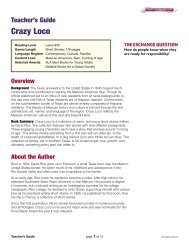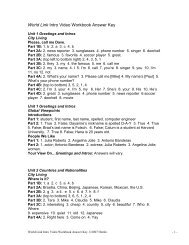English for Cabin Crew Trainer's Guide - Heinle
English for Cabin Crew Trainer's Guide - Heinle
English for Cabin Crew Trainer's Guide - Heinle
You also want an ePaper? Increase the reach of your titles
YUMPU automatically turns print PDFs into web optimized ePapers that Google loves.
UNIT<br />
7 Case study<br />
LEAD IN Speaking<br />
Write the headline to the article in mixed-up <strong>for</strong>m on the board.<br />
For example: criticized to <strong>Crew</strong>’s incident response take-off<br />
Ask students to work in pairs to put the words in the correct<br />
order to make a headline (<strong>Crew</strong>'s incident response to take-off<br />
criticized). Then ask, What do you think the article will be about?<br />
EXERCISE 1 Reading<br />
Give students time to read through the events and the question. Then<br />
ask them to read the text and put the events in order. Let students check<br />
their answers in pairs be<strong>for</strong>e getting feedback in open class.<br />
Answers<br />
1 a 3 b 1 c 7 d 5 e 8 f 6 g 2 h 4<br />
2 The cabin crew moved passengers to other seats and even tried to<br />
release oxygen masks with their ID cards.<br />
Vocabulary in context<br />
Check the following words from the text, all of which are connected with<br />
one thing coming into physical contact with another: hit, strike, bang,<br />
bump. Use mime to show meaning.<br />
EXERCISE 2 Speaking<br />
The aim here is to get students talking about their personal experiences.<br />
Give students time to read through the questions and think of responses.<br />
Ask them to discuss their responses in pairs or small groups. After a few<br />
minutes, get one student from each pair or group to briefl y summarize<br />
the main points of their discussion.<br />
Pre-teaching vocabulary<br />
Check the following phrases: aborting the take-off (suddenly stopping<br />
it); swerving from side to side (moving uncontrollably); white knuckles<br />
(when the joints in the middle of your fi ngers go white because of fear);<br />
jerking from side to side (moving uncontrollably and in a bumpy, violent<br />
way); dart out of a seat (jump and run quickly from a seat); impeding<br />
passengers (blocking them and slowing them down).<br />
EXERCISE 3 Listening<br />
Give students time to read the situation and the questions. Play the<br />
recording. Students listen, take notes, then discuss their answers in<br />
pairs. Get feedback in open class at the end.<br />
EXERCISE 4 Listening<br />
Give students time to read through the tasks. Then play the recording.<br />
Ask students to make notes in preparation <strong>for</strong> speaking and fi ll in the<br />
missing words in the third task. Let students check their answers in pairs<br />
be<strong>for</strong>e getting feedback in open class.<br />
Answers<br />
1 V1: There was instrument failure just be<strong>for</strong>e V1, which is the point at<br />
which an aircraft is committed to leaving the ground.<br />
braking: This caused the aircraft to swerve violently.<br />
senior crew member: He was so scared that she could see the veins in<br />
his neck.<br />
people in the Business class section: She could see the fear in their<br />
faces and the knuckles on their hands were white as they held on tightly<br />
to their arm-rests.<br />
communication from the fl ight deck: There wasn’t any (presumably the<br />
crew were too busy trying to control the aircraft).<br />
2 announcements from the captain: The captain’s communication<br />
skills were excellent.<br />
the tyres on the aircraft: All the tyres except three had burst.<br />
the fuel tanks: They were in the wings, so the captain didn’t want the<br />
exit doors over the wings to be opened, although two passengers did<br />
open them; <strong>for</strong>tunately they did not explode.<br />
passengers behaving selfi shly: One woman with two children jumped<br />
out be<strong>for</strong>e them, leaving them at the top of the evacuation slide; one<br />
man was determined to take his briefcase, blocking the escape of other<br />
passengers; two passengers opened the wing doors, despite instructions<br />
not to.<br />
3 1 cope 2 stress 3 competent 4 calm 5 drills 6 approach<br />
CD2 Track 7.6<br />
1 What was the most serious emergency you experienced?<br />
S: One of the most horrible situations I experienced was a fl ight leaving Lusaka,<br />
Africa, and we’d as a crew had a wonderful ten days in Africa doing safari<br />
and all excited about going home, you know, to show our friends all the<br />
wonderful photos, and on take-off at V1 just be<strong>for</strong>e V1 which is the point the<br />
aircraft must leave the ground, there was an instrument failure and the pilot<br />
was fl ying the aircraft and needed to have a speed of 140 knots but at V1 at<br />
this point where the aircraft must take off, the captain’s speed went down<br />
to 80 knots so they took an unprecedented decision in aborting the take-off<br />
at V1 and this was unplanned, no crew knew about what was happening.<br />
All we knew that the aircraft suddenly came into brake <strong>for</strong>m and the aircraft<br />
started swerving violently from left to right and I can remember as a junior<br />
stewardess at the time looking at my senior crew member and he had veins<br />
popping out of his neck. He was obviously, you know, really, really scared. My<br />
crew were looking quite terrifi ed. As I looked down the cabin I could see into<br />
the Business class section and I saw fear on people’s faces and their knuckles<br />
were white and stretched as they were grabbing their arm-rests and all this<br />
time the aircraft was shaking violently from left to right; had completely lost<br />
control of, you know, going straight. At the time I felt the nose had lifted<br />
up because I was sitting at the doors one left which is at the front of the<br />
aircraft and I remember feeling the sensation of going up and then feeling<br />
the bang as the nose wheels came back down, but I’ve since been told that<br />
that couldn’t possibly happen so I would imagine that it was just braking at<br />
that crucial point, which was quite severe braking and that in itself created<br />
lots of secondary problems <strong>for</strong> us as fl ight crew. We had no communication<br />
from the fl ight deck during that initial, sort of, 20/30 seconds. It was a very<br />
frightening experience particularly because as an experienced fl ight crew you<br />
gauge when you are going to be taking off and I knew we’d been going along<br />
that runway <strong>for</strong> at least 25/30 seconds and gaining speed all the time, so<br />
I knew take-off was imminent and the fact that we were suddenly swerving<br />
and literally going violently from left to right with the wing tips, you know,<br />
virtually touching the ground, was very, very scary and no communication<br />
from the fl ight crew. So that Lusaka experience was one of the most serious<br />
emergency situations I’ve encountered through my fl ying career.<br />
2 Did you ever have to evacuate passengers?<br />
S: That emergency called <strong>for</strong> an immediate evacuation. The captain did come<br />
on to the announcement at that point and apologized to the passengers<br />
that we had had such an aborted take-off and he quickly explained that his<br />
instruments had failed and he had decided to abort the take-off, but there<br />
was no worries, no problems. We would sit and we were going to taxi back to<br />
the airport. But in fact what had happened through that violent braking, all<br />
the tyres on the aircraft had burst, bar three, so this meant that the captain<br />
had no steering facility which was why the aircraft was jerking so severely<br />
from left to right. So he brought the aircraft to a stop and made another<br />
announcement. He was excellent in communicating with the passengers and<br />
the crew immediately. I mean, you know, I commend his communication skills<br />
on that occasion, but the evacuation had to take place because we couldn’t<br />
move the aircraft and basically the heat from that braking was getting to a<br />
danger point near the fuel tanks, so evacuation via the slides had to take<br />
place. Evacuating the passengers – it was the fi rst time I’d ever had to do<br />
this in my fl ying career and your brain goes into automatic. All the training<br />
that you’ve taken in and absorbed through every year you are fl ying suddenly<br />
comes into play and once the aircraft had stopped and the captain had told<br />
us we were to evacuate, as I said, your training comes into the front and<br />
31



